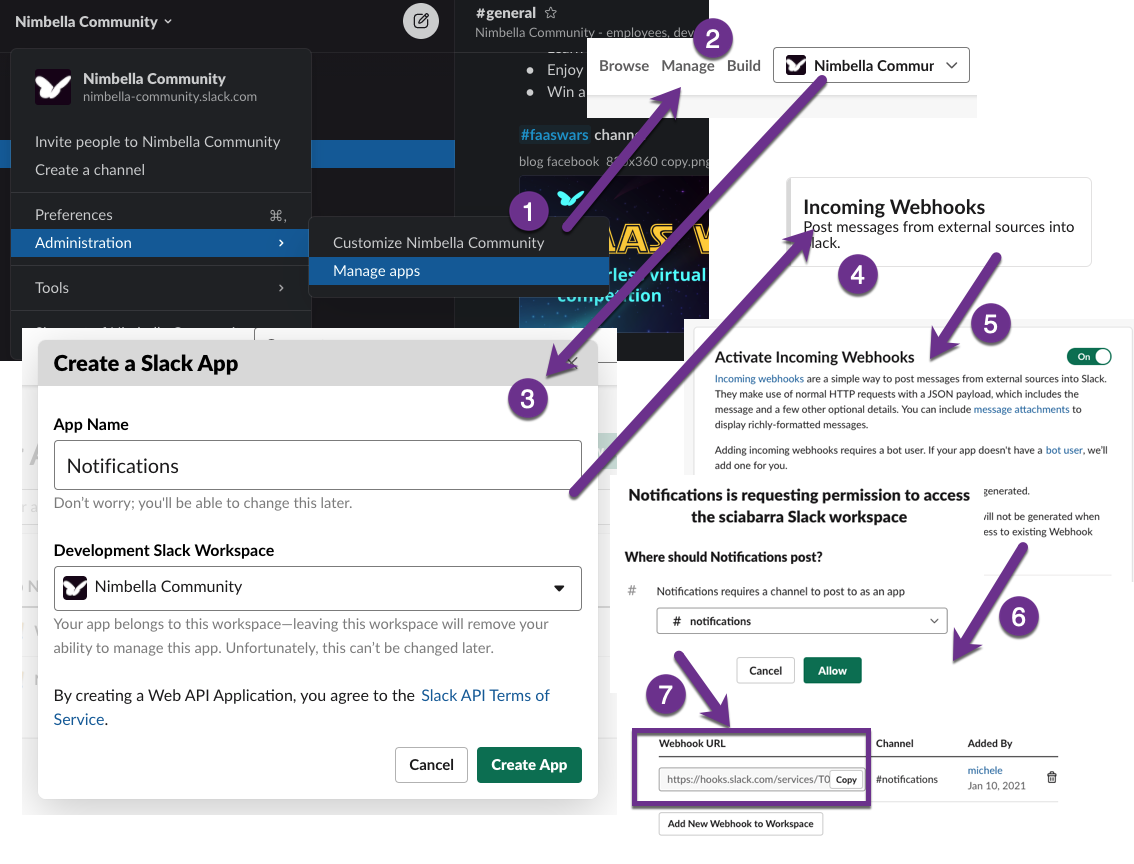Contact Notification
It would be great if we receive a notification when an user tries to contact us. For this tutorial we will pick slack to receive a message when it happens.
We need to:
-
have a slack workspace where we can send messages;
-
create a slack app that will be added to the workspace;
-
activate a webhook for the app that we can trigger from an action;
Check out the following scheme for the steps:

Once we have a webhook we can use to send messages we can proceed to create a new action called notify.js (in the packages/contact folder):
// notify.js
function main(args) {
const { name, email, phone, message } = args;
let text = `New contact request from ${name} (${email}, ${phone}):\n${message}`;
console.log("Built message", text);
return fetch(args.notifications, {
method: 'POST',
headers: {
'Content-Type': 'application/json',
},
body: JSON.stringify({ text }),
})
.then(response => {
if (!response.ok) {
console.log("Error sending message. Status code:", response.status);
} else {
console.log("Message sent successfully");
}
return {
body: args.body,
};
})
.catch(error => {
console.log("Error sending message", error);
return {
body: error,
};
});
}This action has the args.notifications parameter, which is the webhook. It also has the usual 4 form fields parameters that receives in input, used to build the text of the message. The action will return the body of the response from the webhook.
We’ve also put some logs that we can use for debugging purposes.
Let’s first set up the action:
nuv action create contact/notify notify.js -p notifications <your webhook>
ok: created action contact/notifyWe are already setting the notifications parameter on action creation, which is the webhook. The other one is the text that the submit action will give in input at every invocation.
Creating Another Action Sequence
We have developed an action that can send a Slack message as a standalone action, but we designed it to take the output of the submit action and return it as is. Time to extend the previous sequence!
Note that it will send messages for every submission, even for incorrect inputs, so we will know if someone is trying to use the form without providing all the information. But we will only store the fully validated data in the database.
Let’s create the sequence, and then test it:
nuv action create contact/submit-notify --sequence contact/submit-write,contact/notify --web true
ok: created action contact/submit-notifyWe just created a new sequence submit-notify from the previous sequence submit-write and the new notify.
If you want to get more info about this sequence, you can use the nuv action get command:
nuv action get contact/submit-notify
{
"namespace": "nuvolaris/contact",
"name": "submit-notify",
"version": "0.0.1",
"exec": {
"kind": "sequence",
"components": [
"/nuvolaris/contact/submit-write",
"/nuvolaris/contact/notify"
]
},
...
}See how the exec key has a kind of sequence and a list of components that are the actions that compose the sequence.
Now to start using this sequence instead of using the submit action, we need to update the web/index.html page to invoke the new sequence.
As before let’s grab the url:
nuv url contact/submit-notify
<apihost>/api/v1/web/nuvolaris/contact/submit-notifyAnd update the index.html:
--- <form method="POST" action="/api/v1/web/nuvolaris/contact/submit-write"
enctype="application/x-www-form-urlencoded"> <-- old
+++ <form method="POST" action="/api/v1/web/nuvolaris/contact/submit-notify"
enctype="application/x-www-form-urlencoded"> <-- newDon’t forget to re-upload the web folder with nuv web upload web/.
Now try to fill out the form again and press send! It will execute the sequence and you will receive the message from your Slack App.
The tutorial introduced you to some utilities to retrieve information and to the concept of activation. Let’s use some more commands to check out the logs and see if the message was really sent.
The easiest way to check for all the activations that happen in this app with all their logs is:
nuv activation poll
Enter Ctrl-c to exit.
Polling for activation logsThis command polls continuously for log messages. If you go ahead and submit a message in the app, all the actions will show up here together with their log messages.
To also check if there are some problems with your actions, run a couple of times nuv activation list and check the Status of the activations. If you see some developer error or any other errors, just grab the activation ID and run nuv logs <activation ID>.